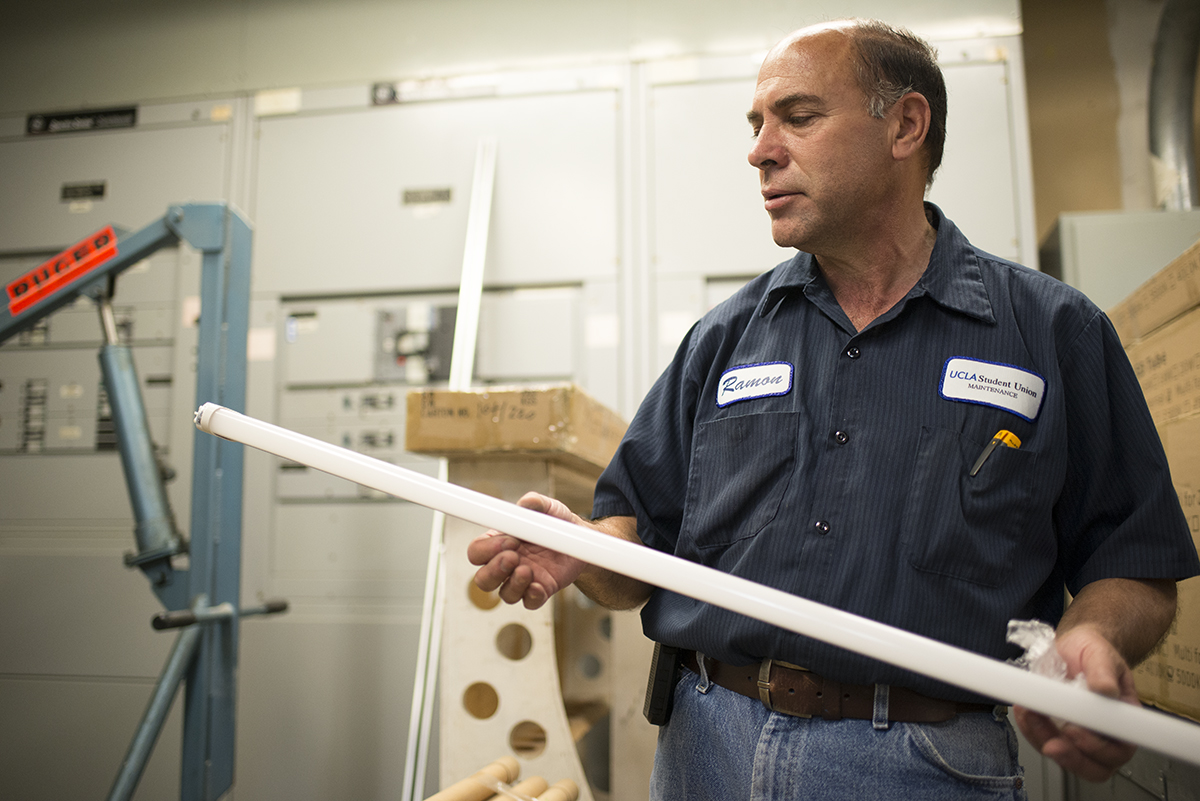ASUCLA works to lower utility costs

Ramon Rigual, an ASUCLA electrician, shows new cost-saving LED lights bulbs that are being installed in several ASUCLA buildings. (Neil Bedi/Daily Bruin senior staff)
By John Peter Cavender
May 20, 2014 4:16 a.m.
Associated Students UCLA is working to reduce its spending on utilities, after a significant increase in costs in recent years.
In the past two years, ASUCLA exceeded its utilities budget, which includes costs for Ackerman Union, Kerckhoff Hall, Lu Valle Commons, the North Campus Student Center, the Court of Sciences Student Center and portions of the bills for other buildings like Pauley Pavilion and Drake Stadium.
Last year, ASUCLA went over its utilities budget by about $186,000. After budgeting an additional $187,000 for this year’s utilities costs, ASUCLA is still over budget by about $54,000 as of March. Last year ASUCLA’s total utilities bill was close to $1.2 million.
Utilities costs have increased by about 14 percent – or $106,000 – from this time last year.
The association pays its bills with revenue from store and restaurant operations, licensing and student fees. Vendors like Panda Express and Wolfgang Puck Express and student groups like Undergraduate Students Association and Student Media contribute to paying the utilities bill. Last year vendors and student groups paid for 17 percent of the utilities bill.
The utilities cost increases have changed the way ASUCLA thinks about utility efficiency.
Past efforts to reduce ASUCLA’s utilities usage were designed to increase sustainability, said Roy Champawat, the student union director. But now the efforts also aim to lower costs.

According to Champawat, rising utilities rates would, over time, cause student groups that use ASUCLA space to have to pay higher utilities bills.
There are a large number of variables affecting utilities costs in many different buildings, making it difficult to analyze, Champawat said.
“I have to admit that it is confounding … but we are making progress,” he added.
One contributing factor was an electricity rate increase. ASUCLA purchases electricity – its most costly utility – from UCLA.
Near the beginning of this school year, ASUCLA’s electricity rate increased by 7.1 percent, creating a roughly $56,000 increase in electricity costs this year, Champawat said.
Champawat said that based on his talks with UCLA utilities managers and his understanding of what is happening to regional energy costs, the electricity rate will likely rise by another 7 percent next year.
Richard Delia, ASUCLA chief financial officer, said there are two factors that determine how much ASUCLA pays for utilities: price and consumption.
“We have no control over price,” Delia said. “Consumption we can do something about.”
ASUCLA is currently identifying projects to decrease utilities consumption.
In November 2013, ASUCLA received a $24,000 grant from The Green Initiative Fund largely for the purchase of more than 400 LED tube lights, more than 200 of which have been installed in Ackerman to replace fluorescent lights, Champawat said. He added that purchasing the tube lights cost $14,000.
The installation process began in February and is ongoing, Champawat said.
When all the new lights have been installed, they are expected to save ASUCLA more than $8,000 in electricity costs per year, he added.
A decrease in energy use in ASUCLA buildings reflects The Green Initiative Fund’s mission to increase sustainability on campus, said Patricia Zimmerman, UCLA’s grant coordinator for The Green Initiative Fund.
The Green Initiative Fund’s grant also contributed to the funding the April installation of a solar film on a number of Ackerman windows.
The solar film reduces glare and heating in the building, Champawat said. The film, which rejects 65 percent of solar heat, lowers air conditioning costs by keeping the rooms cooler, he added.
Installing the film on the windows of the Ackerman Grand Ballroom, the Bruin Reception Room and three study rooms on the second floor of Ackerman costed almost $29,000, Champawat said.
It is hard to calculate precisely how much the film will save, Champawat said. But it will help lower Ackerman’s energy usage.
The film allows Ackerman to have shades open more often, which gives the room more personality, he added.
The Green Initiative Fund also provided ASUCLA with an additional $26,000 grant in February to retrofit its buildings with low-flow plumbing devices like dual-flushing toilets, Champawat said.
“We are currently working with (Los Angles Department of Water and Power) to see what types of rebates we can receive,” Champawat added
ASUCLA is also looking into ways to cut refrigeration costs.
When a walk-in refrigerator is opened, heat rushes in and triggers the thermostat to kick in unnecessarily – which wastes energy, Champawat said.
He said he has ordered 19 gel packs that enclose the refrigerators’ thermostats, preventing them from overreacting to short-term temperature variations. The packs cost about $11,000 and are expected to lower each refrigerators’ energy usage by 15 to 20 percent.
In the preliminary budget for next year, ASUCLA allotted about $77,000 more than it did this year for utilities, Delia said. ASUCLA’s utilities bills are already significantly lower than they would have been if no efforts had been made, Champawat said.
He added he will continue to identify more projects.
“I am going to continue to try to conquer (this issue),” Champawat said. “It’s a beast.”



